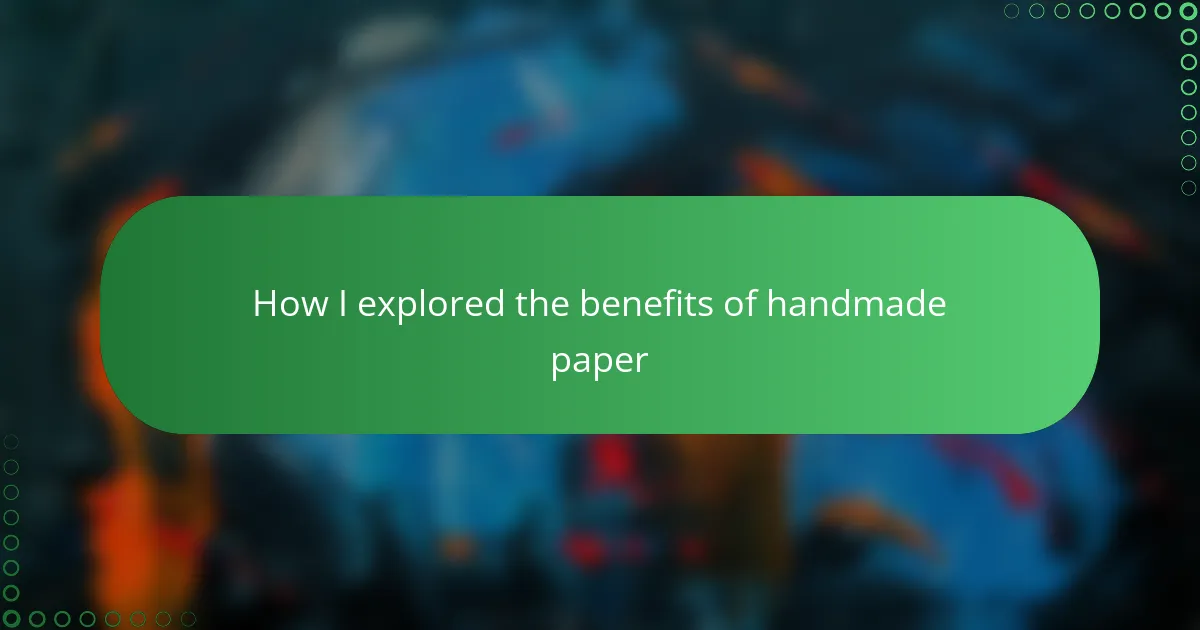Key takeaways
- Handmade paper crafts offer a unique connection between the creator and the material, encouraging patience and creativity.
- The essential materials for making handmade paper include pulp, water, and a mold, allowing for diverse textures and characteristics.
- Creative projects with handmade paper, such as journaling, card-making, and collages, enhance personal expression through tactile experiences.
- Sharing and exchanging ideas about handmade paper crafts fosters community and inspires new creative possibilities.
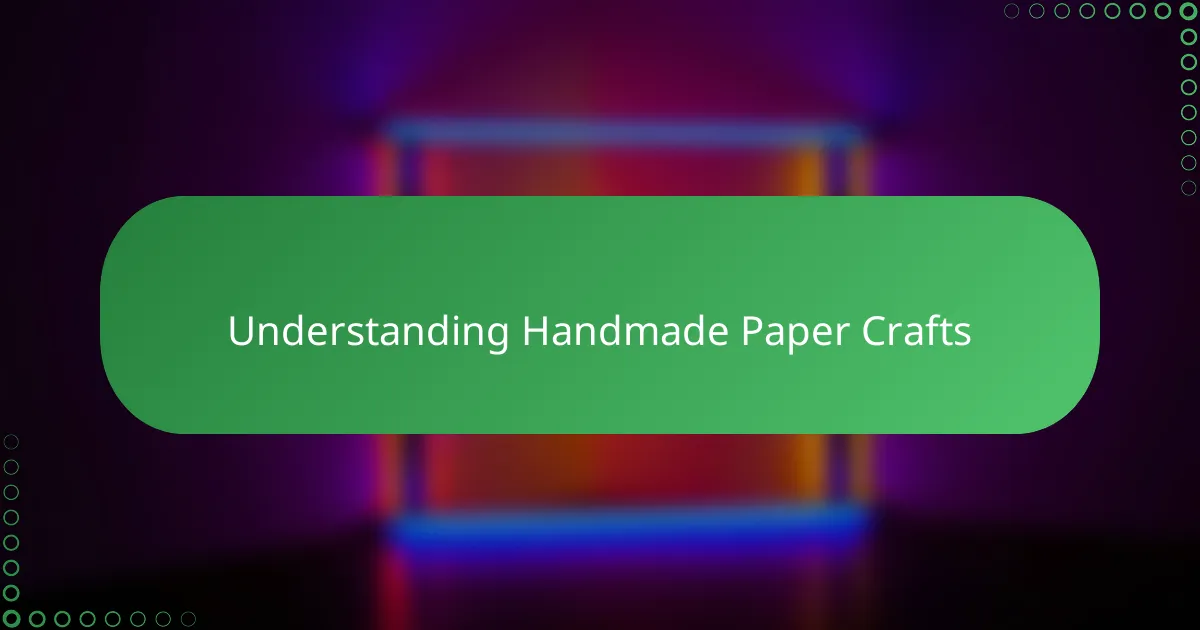
Understanding handmade paper crafts
Handmade paper crafts are a beautiful blend of artistry and tradition, where each sheet tells its own unique story. I remember the first time I felt the delicate texture of handmade paper — it was like holding a piece of history molded by human hands, full of character and warmth. Have you ever thought about how the imperfections in the paper make it more alive and personal compared to machine-made alternatives?
Exploring these crafts, I’ve found that the process demands patience and a mindful touch, creating an intimate connection between maker and material. It makes me wonder: do we lose something vital in the rush for mass production that handmade paper so effortlessly preserves?
The real charm of handmade paper crafts lies in their versatility; whether used for journaling, card-making, or art projects, they invite creativity to flow naturally. Each project feels special because the paper itself is already a piece of handcrafted art, inspiring me every time I sit down to create.
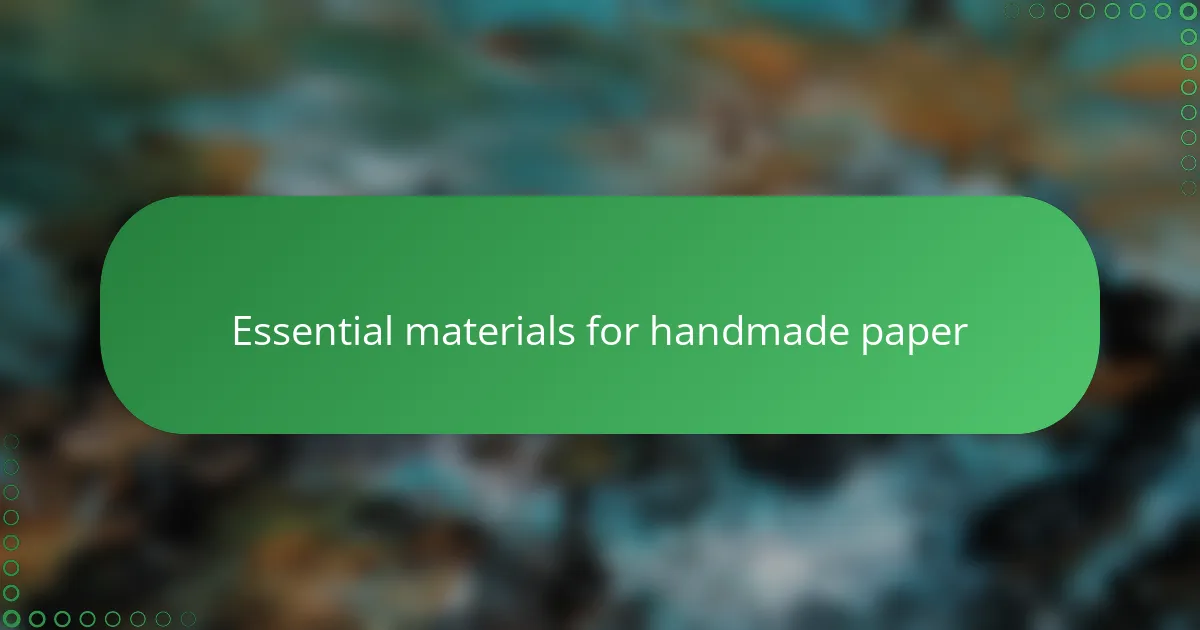
Essential materials for handmade paper
To start making handmade paper, you’ll need just a few essential materials, but each one plays a crucial role. I was surprised at how simple the list was: mainly pulp, water, and a mold and deckle — that wooden frame that shapes the paper. When I first held the mold, it felt like a magic wand guiding the pulp into a new creation.
The pulp itself can come from various sources like cotton, recycled paper, or even plant fibers, and each type influences the paper’s texture and strength. I found experimenting with different pulps gave me so much joy, like discovering new personalities in the paper sheets I made. Have you ever thought about how the raw material can change the whole vibe of your craft?
Lastly, water is more than just a mixing agent; it balances the fibers and helps the formation process. Watching the fibers settle in water reminded me how patience is key — just like in life, you can’t rush true artistry. Do you feel this slow rhythm when you work with handmade paper, as if the material itself is teaching you to slow down and focus?
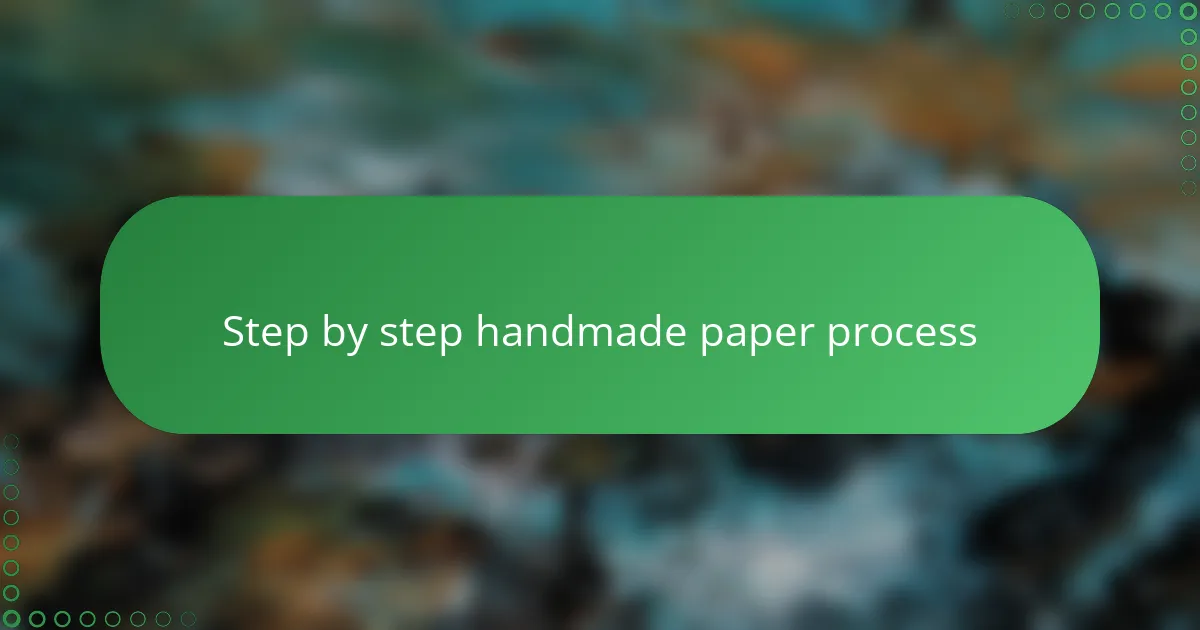
Step by step handmade paper process
Starting the handmade paper process, I first soak the pulp in water until it becomes a smooth slurry. This step always fascinates me because it’s like awakening the fibers, giving them a chance to mingle and prepare for transformation. Have you noticed how the water softens everything, making the pulp ready to be shaped?
Next comes the dipping with the mold and deckle, where the real magic happens. I gently pour the pulp mixture over the frame, feeling the fibers settle and form a thin, fragile sheet. It’s a moment that requires a steady hand and quiet focus—do you ever find this step meditative, almost like a mindful pause in a busy day?
After lifting the wet sheet, the drying process begins, which I’ve learned requires both patience and care. Watching the paper slowly dry taught me that some things can’t be hurried; each sheet dries unevenly, showing textures and character unique to that moment. Doesn’t that remind you how imperfections often create the most beauty?
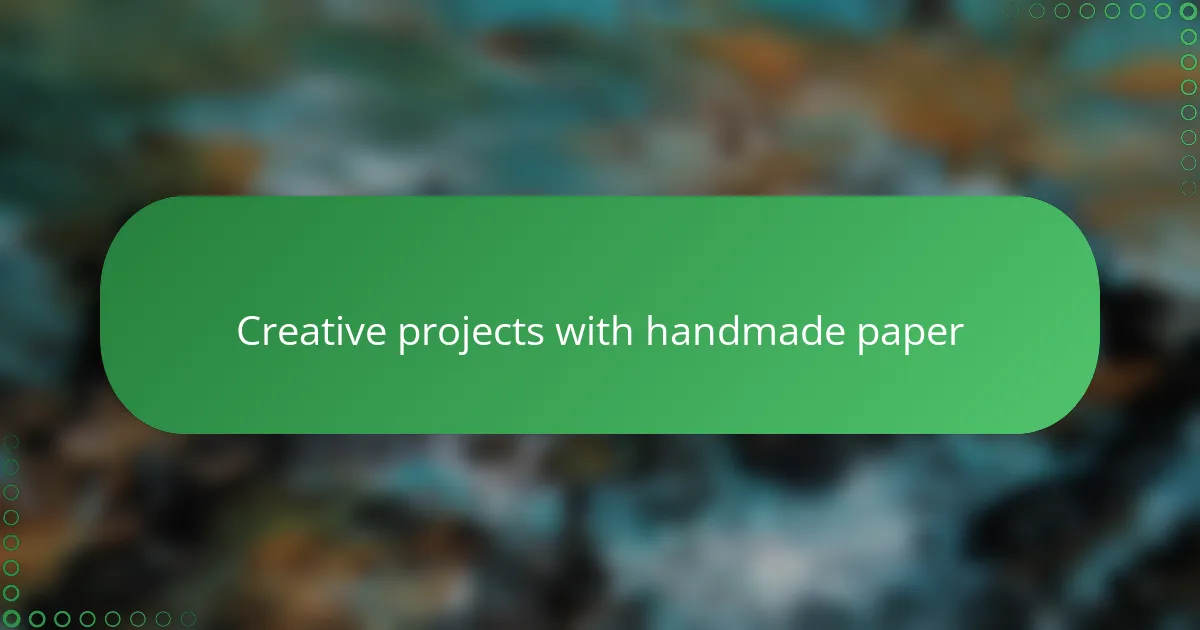
Creative projects with handmade paper
Working on creative projects with handmade paper has always been a source of endless inspiration for me. I once tried making greeting cards using vibrant pigments mixed into the pulp, and seeing how the colors naturally blended into the paper felt like watching a surprise masterpiece unfold. Have you ever experimented with adding your own touches before the sheet even dries? It transforms the process into a truly personal journey.
I also enjoy how handmade paper lends itself beautifully to layering techniques, like collage or mixed media art. There was one project where I combined pressed flowers with textured handmade sheets, and the delicate irregularities in the paper gave the piece an undeniable depth and charm. Don’t you think these subtle details make every creation stand out as an original?
Beyond art, I found that handmade paper is perfect for thoughtful journaling or scrapbooking. Writing on those tactile surfaces somehow slows me down, helping me connect more deeply with my thoughts and memories. Have you noticed how the feel of the paper beneath your pen can influence your mindset? For me, it’s a quiet kind of magic that adds meaning to every word.

Experiencing the benefits firsthand
Feeling the texture of my first handmade paper sheet was a revelation—it wasn’t just paper, but a living piece of art that carried warmth and individuality. Have you ever noticed how that subtle unevenness invites you to slow down and appreciate its story in a way that mass-produced paper never does?
As I continued to work with handmade paper, I realized the benefits go beyond aesthetics. The gentle weight and softness made my writing feel more intentional, almost like the paper itself encouraged me to pour more care into my words. Can you imagine how such a tactile experience can deepen your creative connection?
One memorable moment was when I handed a handmade card to a friend and saw their immediate reaction—there was something special in knowing that the paper itself was crafted with such intention. Isn’t it amazing how experiencing these benefits firsthand gives the craft a soul that no factory assembly line can replicate?
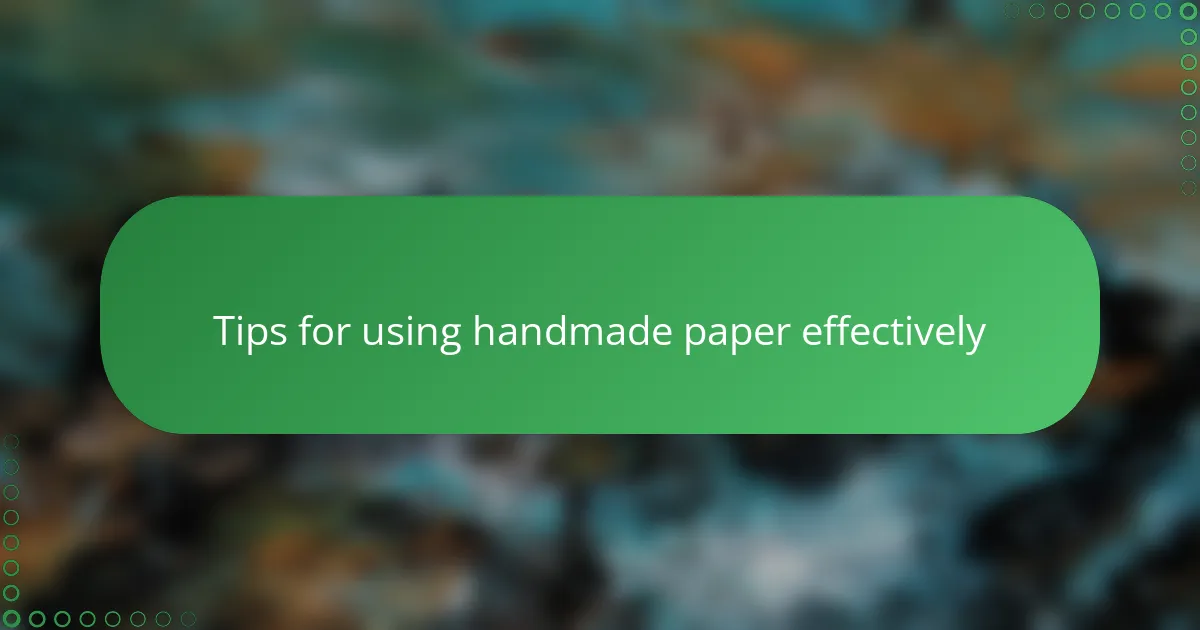
Tips for using handmade paper effectively
When using handmade paper, I’ve found that handling it gently is key. Its delicate texture means it can wrinkle or tear more easily than regular paper, so taking a soft touch preserves its beauty. Have you ever been surprised by how just a slight crease can add character—or sometimes spoil your creation?
Another tip I swear by is using the right ink or paint. Handmade paper often soaks up liquids more, which can blur fine details if you’re not careful. I like testing my pens and brushes on a scrap sheet first to avoid any unwelcome surprises—do you think this little precaution can save hours of frustration?
Lastly, I always try to embrace imperfections rather than fight them. Each ripple, fiber, or uneven edge tells part of the paper’s story, adding charm to the final piece. Have you noticed how those quirks can turn a simple craft into a conversation starter? It’s these unique traits that make handmade paper truly special.
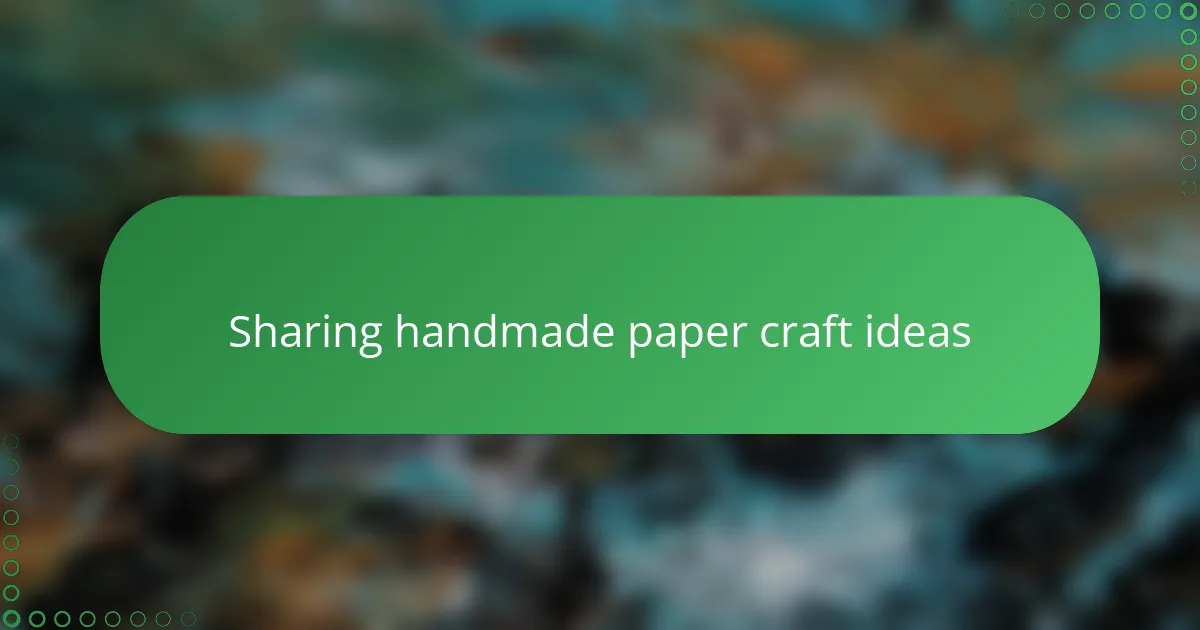
Sharing handmade paper craft ideas
Sharing handmade paper craft ideas has been one of the most rewarding parts of my journey. I remember the first time I showed a simple greeting card made from recycled fibers to a friend; their excitement sparked a whole conversation on how small creative shifts can make a big difference. Have you ever felt that thrill when someone loves the idea behind your craft as much as the craft itself?
I often find that exchanging ideas about textures, layering, or adding natural elements like leaves opens up new creative doors for everyone involved. In my experience, these shared moments not only inspire fresh projects but also build a sense of community around something as tactile and personal as handmade paper. Doesn’t collaborating on craft ideas make the whole process feel richer and more connected?
Sometimes, I encourage others to experiment by mixing unexpected materials into their pulp or trying out new folding techniques for cards and journals. It’s amazing how these little twists lead to unique, one-of-a-kind pieces that carry a story beyond the paper itself. What’s an idea you’ve shared or received that transformed the way you look at handmade paper?
